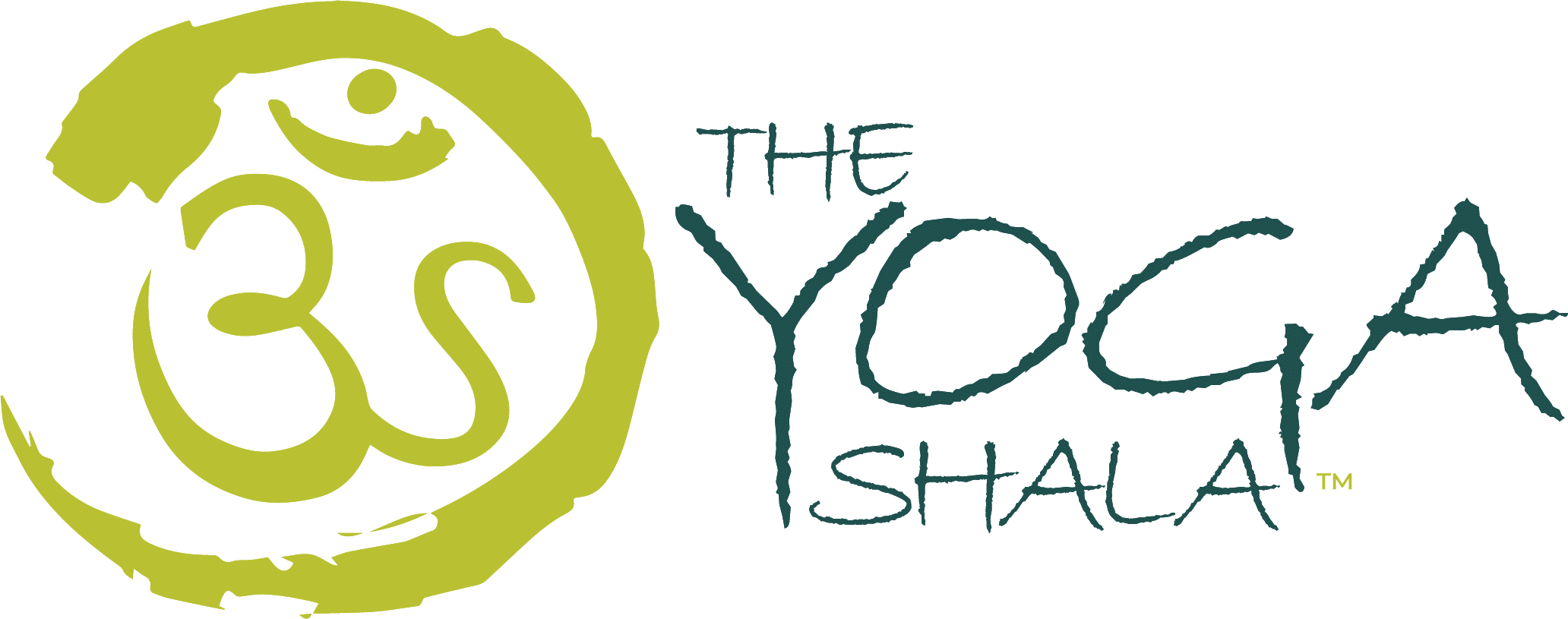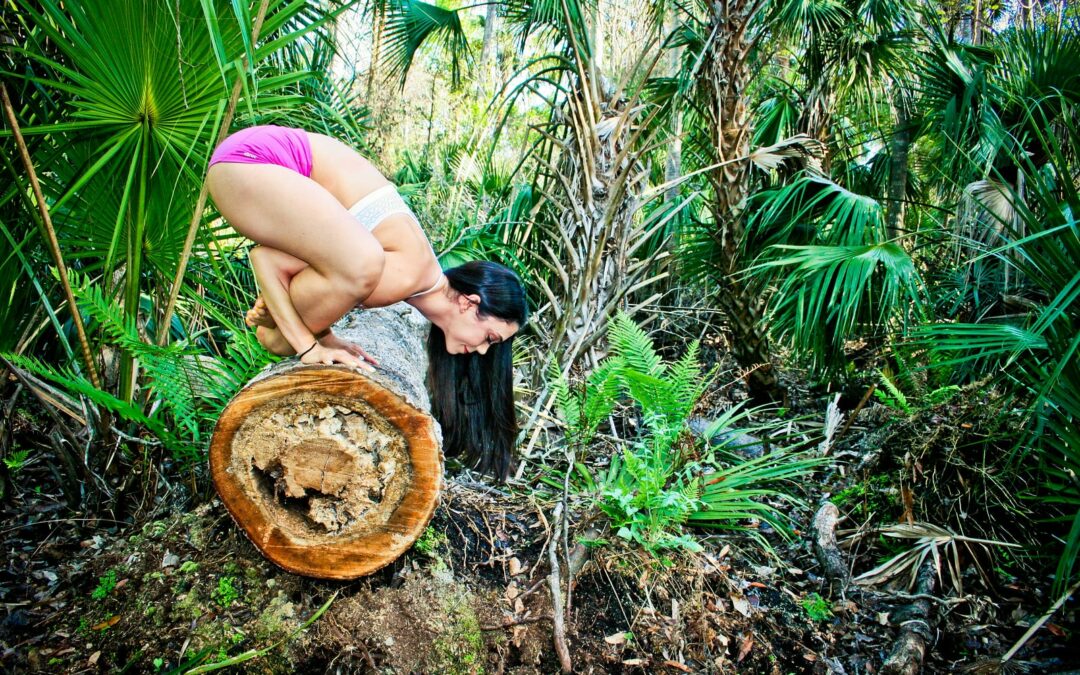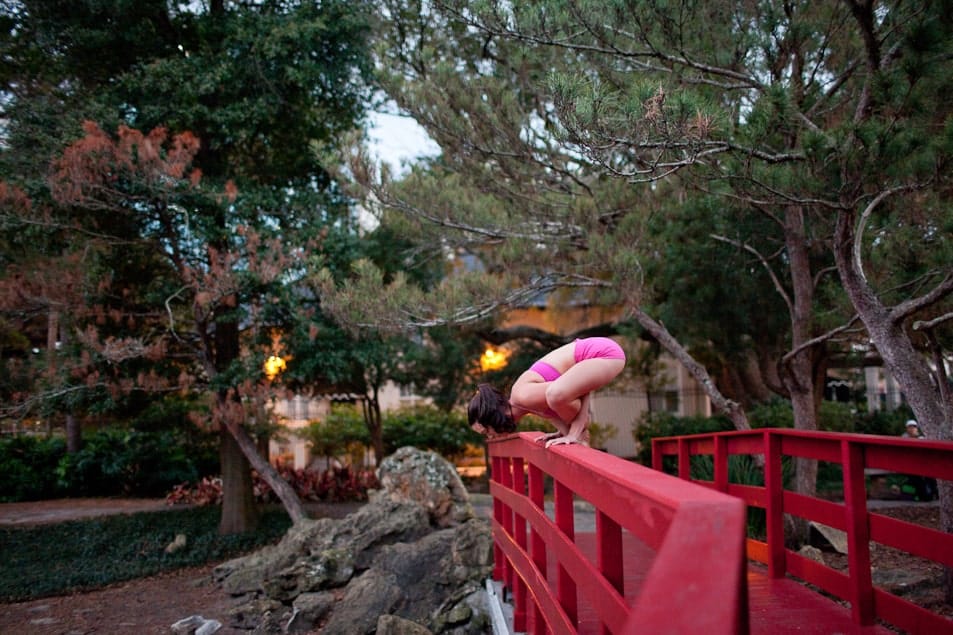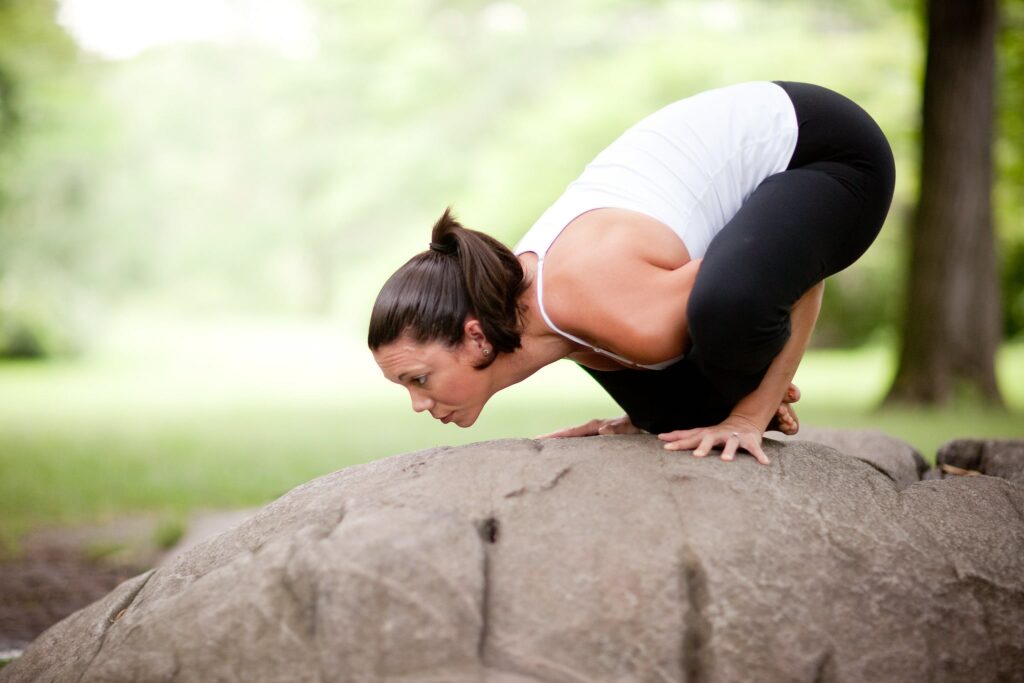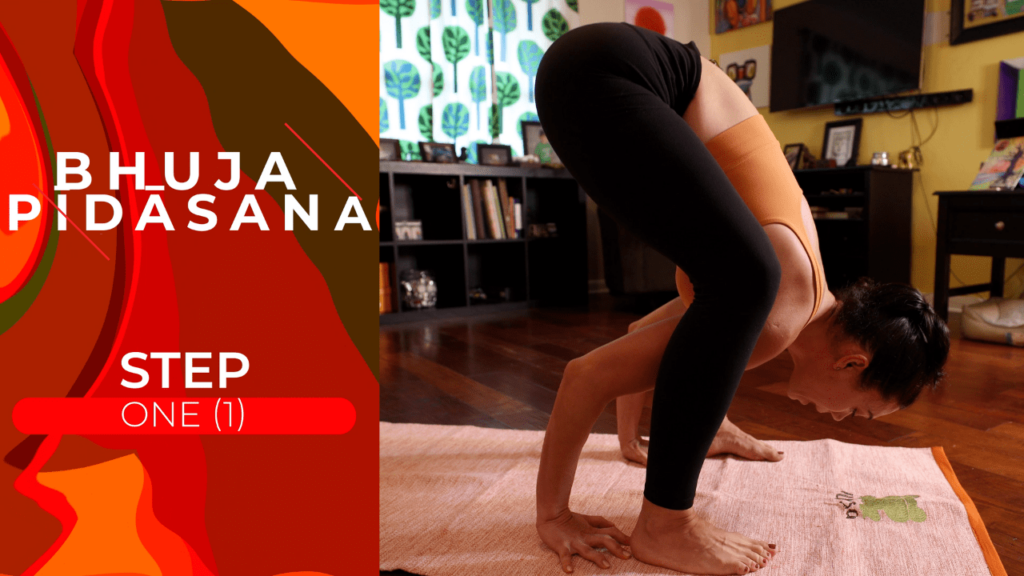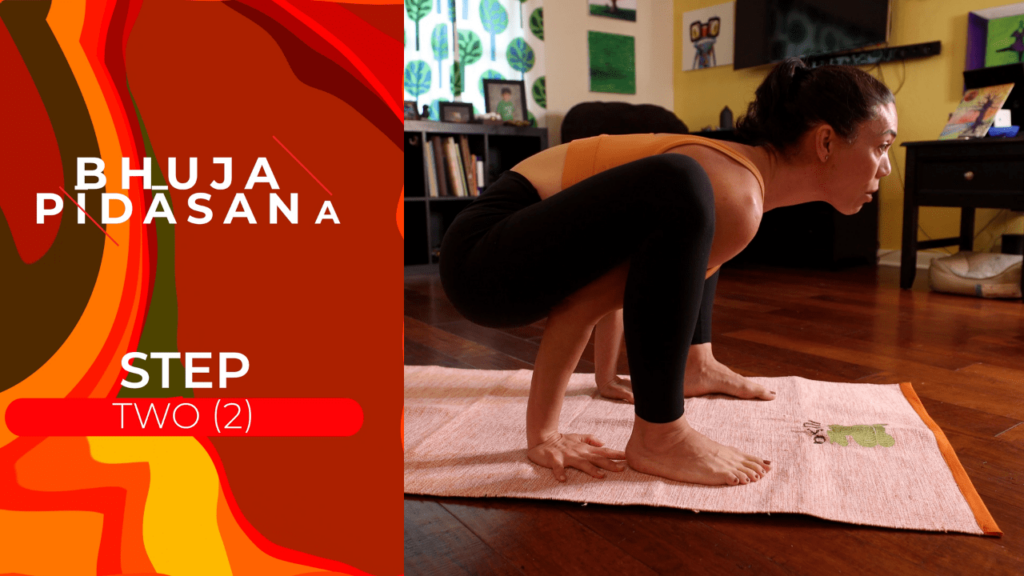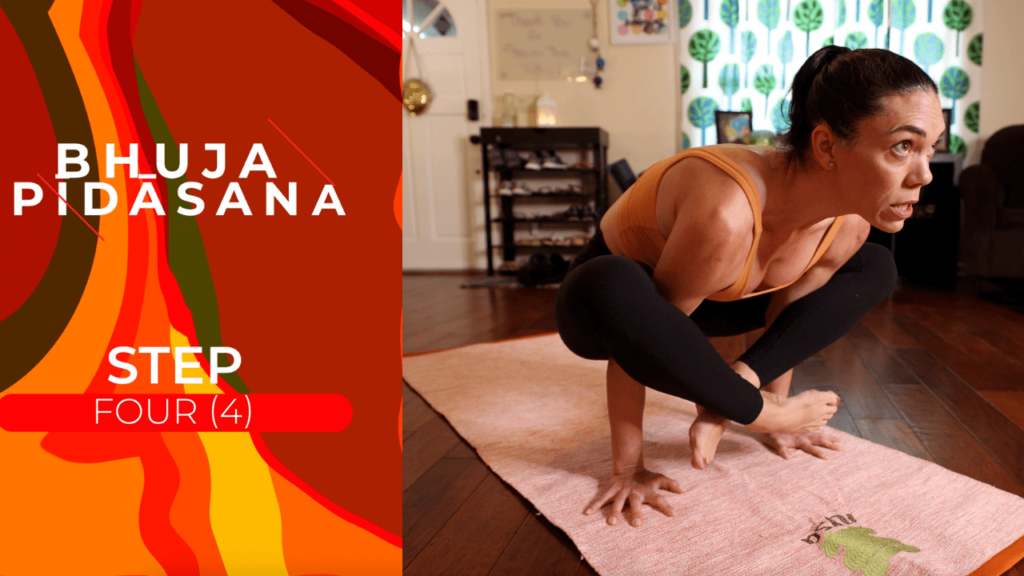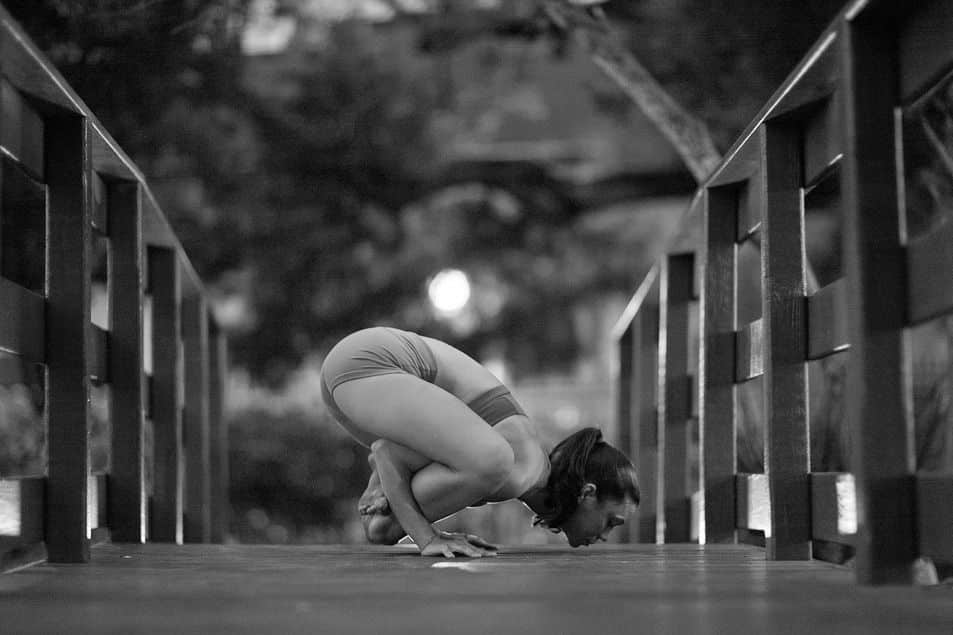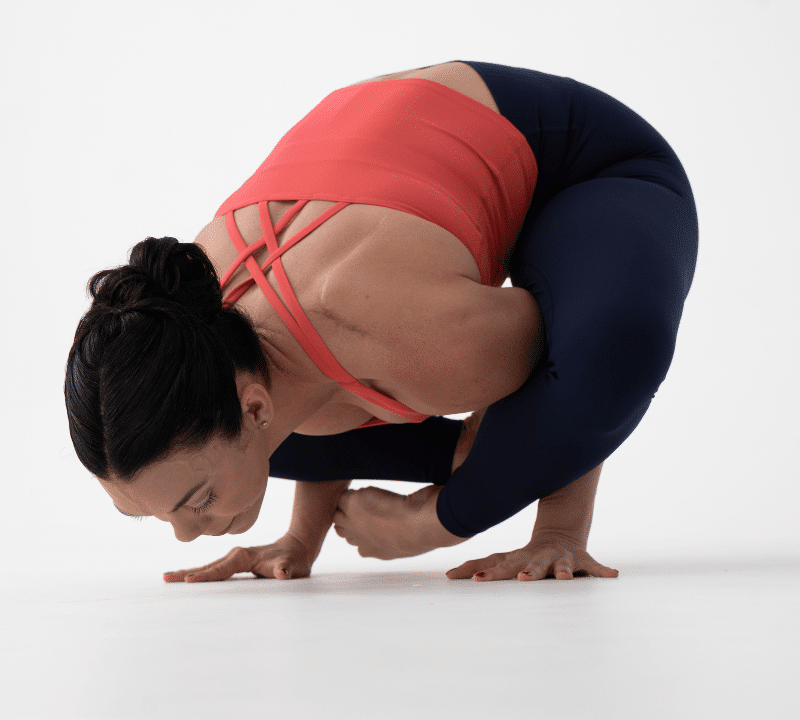Ashtanga Yoga is a dynamic and structured yoga practice that challenges both the body and mind. One such jewel in the crown of the Ashtanga Primary Series seated sequence is Bhujapidasana, a pose that demands strength, flexibility, and focus. In this blog post, we’ll dive into the intricacies of Bhujapidasana, exploring its benefits, steps, variations, and our five special steps for mastering it.
The Essence of Bhujapidasana
Bhujapidasana translates to Arm Pressure Posture or Shoulder Pressing Pose. Bhuja, means arm/shoulder, Pida, means pressure, and Asana, means pose. It is the fourteenth seated posture in the Ashtanga Yoga Primary series. Bhujapidasana comes after Navasana in the Primary Series (Yoga Chikitsa) and it is the first challenging arm balance from Ashtanga’s first series.
This pose brings together elements of strength, flexibility, and grounding, making it a powerful practice for yogis of all levels. Bhujapidasana challenges the practitioner to engage their core, open their hips, and work on their arm strength, leading to a harmonious integration of body and mind. Devoting the time necessary to properly master Bhujapidasana will give practitioners tools necessary to approach and master more challenging arm balances in 2nd or Intermediate series and beyond.
Benefits of Bhujapidasana
Core Strength:
Bhujapidasana requires significant engagement of the core muscles to lift and balance the body. Regular practice helps strengthen the abdominal muscles, contributing to better posture and overall stability.
Hip Flexibility:
This pose involves a deep hip flexion, which helps release tension in the hips and increase their flexibility. It’s particularly beneficial for individuals who spend long hours sitting, as it counteracts the tightness often experienced in the hip area.
Shoulder and Arm Strength:
Supporting the body’s weight with the arms and shoulders enhances upper body strength. Over time, this can lead to stronger arms, shoulders, and wrists.
Balance and Focus:
Balancing the body on the arms while keeping the feet off the ground demands a high level of concentration and mental focus. Practicing Bhujapidasana enhances mindfulness and concentration, which can carry over to daily life.
Digestive Stimulation:
The compression of the abdomen in this pose can stimulate the digestive organs, potentially aiding digestion and improving overall digestive health.
Mind-Body Connection:
Bhujapidasana requires the synchronization of breath, movement, and concentration. This integration promotes a deeper mind-body connection, fostering a sense of inner harmony and awareness.
Tap here to watch a step-by-step tutorial video on Bhujapidasana
Contraindications and Cautions
While Bhujapidasana offers numerous benefits, it’s important to approach the pose with caution and awareness, especially if you have certain conditions. Here are some contraindications and precautions to consider:
Wrist Issues:
Individuals with wrist injuries or weaknesses should be cautious when practicing Bhujapidasana, as it places significant pressure on the wrists. Consider modifications to reduce strain on the wrists.
Shoulder Injuries:
Those with shoulder injuries, particularly issues involving the rotator cuff or shoulder impingement, should avoid or modify Bhujapidasana. Consult a yoga teacher or healthcare professional for guidance.
Knee Problems:
If you have knee issues, be mindful of the deep hip flexion required for this pose. Avoid forcing your knees too close to the armpits if it causes discomfort.
Pregnancy:
If you were practicing Bhujapidasana before pregnancy, honor your body and modify as necessary. If you had not started this posture before pregnancy, it is advised that pregnant women avoid Bhujapidasana due to the pressure it places on the abdomen and the potential strain on the wrists. Always consult a healthcare provider before practicing any yoga pose during pregnancy.
High Blood Pressure:
The intense engagement required in this pose might not be suitable for individuals with high blood pressure. Always consult a healthcare professional before attempting advanced yoga poses.
Beginner Level:
Bhujapidasana is an intermediate to advanced pose. If you’re new to yoga or have limited upper body strength, it’s wise to work on foundational poses and gradually build up strength and flexibility before attempting this pose.
Tap here to watch a step-by-step tutorial video on Bhujapidasana
Tips for Success
Consistent Practice: Like any yoga pose, consistency is key. Regular practice will gradually improve your strength and flexibility.
Patience: Don’t be disheartened if you can’t lift your feet at first. Progress might be slow, but with patience, you’ll see improvements over time.
Use Your Breath: Deep, mindful breathing will help you find balance and ease in the pose.
Step-by-Step Instructions for the Full Expression of Bhujapidasana with Sanskrit Vinyasa Count
We will be entering this posture from downward facing dog, having just taken a vinyasa after Navasana to seated position.
Sapta (Vinyasa #7): From Adho Mukha Svanasana (down dog), look forward and jump your feet around your arms (to balance on your hands). As you exhale and once you jump your legs around your arms, work to gently squeeze your thighs around your arms, just above your elbows. Cross your feet, right on top of left, and keep your head up and chest lifted.
Asthau (Vinyasa #8) Exhale and start to bend your elbows as you tilt your hips up and your chin down. This will help you naturally hinge forward as your feet tilt backwards between your arms. Keep your gaze forward the whole time, making sure not to drop your head or your gaze. Hover your chin a few inches above the floor. Take five deep breaths here.
Throughout the posture, continue to gently engage your inner thighs to help you maintain the integrity of the posture. Deep breathing with sound and connect with Mula Bandha. Don’t round your upper back but instead maintain extension through your chest by gently engaging your latissimus dorsi throughout the asana.
Nava (Vinyasa #9) Inhale, lift your head and lengthen your spine, keeping your chest open. At the same time, straighten your legs out in front of you.
Dasa (Vinyasa #10) As you exhale, swing your legs backwards to rest on your triceps. Inhale there.
Ekadasa (Vinyasa #11) Exhale and jump back into Chaturanga Dandasana.
Dvadasa (Vinyasa #12) Inhale into Urdhva Mukha Svanasana(Upward facing dog)
Trayodasa (Vinyasa #13) Exhale into Adho Mukha Svanasana (Downward facing dog)
Tap above or click here to watch a step-by-step tutorial video on Bhujapidasana
Bhujapidasana requires both strength and balance. If you find the full expression of Bhujapidasna is not yet accessible to you, start with our 5 special steps (below) to help you safely work towards mastery of this posture. If you are consistent with the modifications, you will soon develop incredible strength in your wrists, arms, chest, hands, shoulders, and upper back. You’ll also notice improvement in flexibility of your pelvis and hips and great core strength. As your flexibility, strength and stamina increase, you will master the full expression of Bujapidasana. Just keep practicing!
Bhujapidasana Modifications
If you have limited flexibility or weakness in your shoulders, arms, back, wrists, hands, hips or hip flexors you may struggle to approach, let alone perform the full expression of Bhuja Pidasana. But do not give up! If you approach this asana in steps, you will allow your body to approach the posture where you are currently, and safely build up the strength, flexibly and stamina you need to move to the next step and then the next. Doing it this way allows you to practice this difficult asana and tangibly build up to the full expression of this yoga posture.
I am a huge believer in helping students approach the practice where they are, and give them tools to grow in their body and their practice over time. In all of my yoga classes, I teach Bhujapidasana in five (5) special steps. Let’s break each step down so you can start to explore with this asana. Begin with step one and continue working with that step until you’ve mastered that modification. Once you have, start working with step two, then three and so on. If you practice these modifications consistently, there is no doubt you will eventually master the full expression of Bhujapidasana.
Variation One (1)
Start this modification from downward-facing dog. Walk your feet forward in front of your hands. Bend your knees and work to get your hands right behind your feet with palms flat. If you find that you cannot flatten your wrists and/or keep your hands directly behind your feet, press up more through your hips.
By pressing your hips up towards the ceiling when working to press your hands downward into the ground, you are working with tensegrity or oppositions of force. With concsistent practice, this will help you safely get your palms flat to the floor behind your feet.
Breathe here for five deep breaths. This modification will help you build up the necessary strength and stamina to move onto the next variation. At the end of your fifth breath, stand up slowly and release the pose, step your feet back into high and then low plank and finish your vinyasa. This modification is an excellent place to build up your strength, stamina, flexibility and endurance necessary to move onto step two.
Variation Two (2)
Start variation or modification two when you are able to comfortably practice modification one. From down dog, walk your feet forward in front of your hands. Take your fee to hip distance apart. Press your palms flat on the ground. Shift your weight back into your hands and sit your hamstrings on your triceps.
Take five deep breaths here. Lift your chin, keep your hands pressed into the floor, and in this variation, feet on the floor. At the end of your fifth breath, either drop your hips all the way to the floor and then take a vinyasa, or stand up to get out of the posture and then take a vinyasa.
Variation Three (3)
Start variation three from down dog. Look forward and walk your feet around your arms. Pressing your palms flat, sit down onto your triceps. Next, shift your body weight onto your hands and lift your feet off the floor. Hold this variation for five deep breaths while engaging your inner thighs to keep your feet lifted off the floor. Flex your feet. Gaze forward and keep your chin up.
Modification three helps you learn the importance of engaging your psoas and your core. If you would like to start exploring the exit for this posture, begin to start trying to straighten you legs after your fifth breath. See if you can swing your feet back so that your shins are resting on your triceps. From there, keeping your gaze forward, jump back into Chaturanga.
Variation Four (4)
Start modification four from down dog. You may choose to try and jump your feet around your hands from down dog, or you may opt to walk your feet around your hands. Next, bend your knees and sit your hamstrings on top of your triceps. Keep you gaze forward as you shift your weight back into your hands and lift your feet off the floor. Cross your legs, right foot on top of left. Point both feet strongly as you gently engage your inner thighs. Breathe here for five deep breaths. Keep your gaze forward, engage your lattisimus dorsi to help keep your chest open and control the shoulders from rounding too much.
After your fifth breathe in modification four, straighten your legs. Keeping your gaze forward, take your legs back onto your triceps. If you can maintain the balance here, jump back into chaturanga and finish your vinyasa.
The fifth step to my five special steps is the full expression of Bhujapidasana. Once you find you are comfortably able to do variation four, you are ready for the full expression of arm pressure posture!
Bhujapidasana, a dynamic arm balance within the Ashtanga Yoga Primary Series seated sequence, offers a range of physical and mental benefits. Its emphasis on core strength, hip flexibility, and concentration can be incredibly rewarding for practitioners who approach it with mindfulness and respect for their body’s limitations. However, as with any yoga pose, it’s crucial to practice Bhujapidasana mindfully and with awareness of your individual needs and physical conditions. If you’re unsure whether this pose is suitable for you, consult a qualified yoga teacher or healthcare professional before incorporating it into your practice. Click here to watch our full tutorial on Bhujapidasana.
Practice with The Yoga Shala
If you want to join us for LIVE classes, The Yoga Shala offers virtual and in person classes every weekday morning. We are located at 140 Circle Drive, #4, Maitland, Florida. Owner, Krista Shirley, also offers virtual or in person private sessions (Yoga, Meditation, Breath-work, Nutrition, Life Coaching and Mentorship). Visit theyogashala.com for details.
Be sure to signup for our newsletter to stay on top of local events and classes, Nysa products sales, new offerings, new products and more!
We hope you find this video series helpful to you in creating or maintaining your yoga practice!
About Krista
Krista Shirley is a level II authorized Ashtanga Yoga teacher. She is deeply passionate about sharing these teachings with all who wish to learn.
If you want to join Krista in person she teaches daily classes at The Yoga Shala in Maitland, Florida. She also offers virtual sessions in Yoga, Meditation, Breath-work, Nutrition, Life Coaching and Mentorship. Check out www.theyogashala.com for more details.
If you do not live in Central Florida and want to find an authorized teacher in your area, check out our teacher, Sharath Jois’ website, for a list of all teachers authorized and certified by his yoga centre in India.
|
|
|
|
|
|
|
|
|
|
|
|
❤️SHOP MERCHANDISE: Nysa Products
❤️LET’S BE SOCIAL:
Instagram: Krista Shirley Yoga
Instagram: The Yoga Shala
Facebook: The Yoga Shala
Facebook: KristaShirleyYoga
For other inquires please contact: [email protected]
